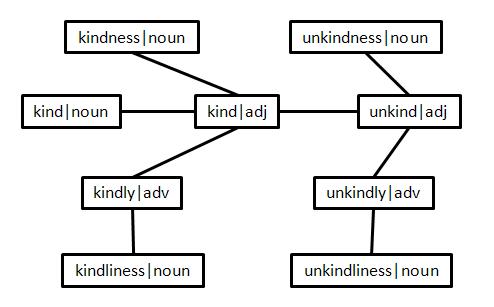Derivational Pairs in Lexical Tools
I. Derivational Pairs
In lexical tools, we use derivational pairs to code derivational variants. For example, kind|noun, unkind|adj, kindness|noun are derived from kind|adj by conversion (category is changed from adjective to noun), prefix (“un”), and suffix (“ness”), respectively. If all related derivational terms are arranged in a graphic network, then there cannot be such a word as “most primitive”. Any word can be considered as the most primitive (root) word and all others can be viewed as being derived from it. The information of such a derivational pair (not including which word is the root word) are coded in Lvg because only the information of derivational variants is needed in NLP applications. Accordingly, derivational pairs are bi-directional. For example, we can consider kindness|noun is derived from kind|adj or vice versa.
The following diagram shows the derivational network for the “kind” family. Each link and the associated two nodes in the diagram define a derivational pair. For example, kindness|noun and kind|adj compose a derivational pair because they are connected directly. This derivational pair is coded in the format as:
kindness|noun|kind|adj
in the derivational table (Fact) in the Lvg. Derivational pairs include base forms and syntactic category information and they are bi-directional. Derivational pairs can be categorized into three types: zero derivation (zeroD), prefix derivation (prefixD), and suffix derivation (suffixD). Term in a derivational pair can only involve one derivational affix or none (zero conversion).
On the other hand, terms are not connected directly cannot compose a derivational pair. For example, kindness|noun and kindly|adv cannot compose a derivational pair because they are not directly connected to each other but are connected through kind|adj. There are two derivational generation flow components in Lvg: direct (-f:d) and recursive (-f:R) to handle both cases. The recursive derivational flow also provides the distance (number of derivational pairs involved). For example, kindness|noun and kindly|adv has a distance of 2 because two directional pairs are involved in the derivations generation.

II. More Examples
The following derivation pair means "ability" is a derivational variant of "able" and "able" is a derivational variant of "ability" (instead of "ability" is derived from "able").
ability|noun|able|adj|yes
Also, derivations in lexical tools only allow one affix (or one derived step). In other words, two steps of derivations are not allowed. However, they can be retrieved through recursive derivations flow component. For examples, "unhappy" and "happiness" are not derivational variants while they can be retrieved by recursive derivations.
- unhappy|adj|happy|adj|yes
- happy|adj|happiness|noun|yes
- unhappy|adj|happiness|noun|no
- unhappy|adj|unhappiness|noun|yes
More multi-step derivations are shown as follows:
- irradiation|noun|irradiate|verb|yes
- irradiate|verb|irradiated|adj|yes
- irradiated|adj|nonirradiated|adj|yes
- irradiation|noun|nonirradiated|adj|no
- nonirradiation|noun|nonirradiated|adj|yes
- non-violent|adj|non-violence|noun|yes
- non-violence|noun|violence|noun|yes
- non-violent|adj|violence|adj|no
- violence|adj|violent|adj|yes
- fertile|adj|fertilize|verb|yes
- fertilize|verb|fertilizer|noun|yes
- fertile|adj|fertilizer|noun|no
Examples shown bellows (in red) are not derivations (not because of multi-step).
- long-winded|adj|long-windedness|noun|yes
- winded|adj|windedness|noun|yes
- long-winded|adj|windedness|noun|no
- high-minded|adj|high-mindedness|noun|yes
- high-minded|adj|mindedness|noun|no
- rod-shaped|adj|rod|noun|no